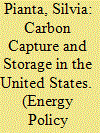|
|
|
Sort Order |
|
|
|
Items / Page
|
|
|
|
|
|
|
| Srl | Item |
| 1 |
ID:
177466


|
|
|
|
|
| Summary/Abstract |
What are the key factors that drive actual uptake of home battery storage? This paper uses linear probability and probit regressions with data from an Australian household survey of homes with solar panels to assess a range of economic, policy, social, and locational explanatory variables. We find that capital and policy are important determinants. Households with smaller solar systems are less likely to install batteries, an example of a physical capital effect. Households facing financial pressure, indicative of financial capital constraints, are also less likely to install home batteries. There is also evidence of a policy impact, as smaller solar feed-in tariffs motivate actual battery uptake. This paper is intended as an early contribution to the very sparse literature on actual home-battery uptake; we emphasize the importance of capital and policy analysis in future studies. There are also implications for policymakers including that higher solar feed-in tariffs may delay the battery revolution in some cases.
|
|
|
|
|
|
|
|
|
|
|
|
|
|
|
|
| 2 |
ID:
177450


|
|
|
|
|
| Summary/Abstract |
Although Carbon Capture and Storage (CCS) technologies can potentially play an important role in climate change mitigation efforts, commercial CCS projects are still rare. Knowledge about the technical challenges of these technologies is rapidly advancing, but the challenges related to their public acceptance are still underinvestigated. Here we try to close this research gap by investigating public perceptions of CCS and public attitudes towards policies to scale up these technologies in the United States, where most existing industrial-scale CCS projects are operating. Based on a demographically representative sample of US residents, we find that awareness of CCS is very low. Using a conjoint experiment, we show that policies that outlaw the construction of new coal- and gas-fired power plants without CCS find higher public support than CCS subsidies and increases in taxes on unabated fossil fuel power generation. Public support decreases with rising costs of CCS deployment and decreasing minimal distance requirements of CCS plants from residential areas. Our results provide insights into the political feasibility of a large-scale deployment of CCS and show that specific policy design choices play an important role in influencing public support for policies to scale up these technologies.
|
|
|
|
|
|
|
|
|
|
|
|
|
|
|
|
| 3 |
ID:
177441


|
|
|
|
|
| Summary/Abstract |
The transition to a low-carbon economy poses significant challenges for investors in energy markets, entailing higher uncertainty and not just higher risks. On the back of the ongoing greening in investment preferences, we focus on investors' group behaviour with respect to U.S. energy equities, which lie at the crossroads in this energy transition phase from an old technology that relies heavily on oil, to a new, greener one. Based on a dynamic herding metric, we find that changes in investors' behaviour with respect to green asset allocations require a better information set than in the case of crude oil allocations, for which only information on returns is a relevant driver of behaviour. We argue that policy uncertainty is better than financial risk proxies in reflecting the multidimensional nature of uncertainty and the various risks associated with investing in green energy today. Our findings suggest the need to reduce uncertainty stemming from the policy realm, given its raising impact on investors’ portfolios on the back of higher allocations towards greener assets.
|
|
|
|
|
|
|
|
|
|
|
|
|
|
|
|
| 4 |
ID:
177465


|
|
|
|
|
| Summary/Abstract |
Local economies with immediate ties to coal-fired power generation face acute challenges from energy system transitions, particularly in the United States where energy policy is heavily devolved and uncoordinated. This study employs a community resilience and transition theory framework to examine how federal and state policies enable or constrain transition planning in rural, coal communities in the U.S. West. Our mixed-methods approach incorporates policy and document analysis with in-depth interviews with policy experts and practitioners. We find that the absence of a national energy transition policy exacerbates uncertainty for coal communities, and as a consequence, two distinct and diverging policy corridors emerge at the state level. According to expert interviews, existing transition assistance policies do not align with the needs and capacity of transitioning coal communities. Together, these findings highlight the need for policies that coordinate the energy transition and provide opportunities and resources that support communities navigating the social and economic impacts of transition.
|
|
|
|
|
|
|
|
|
|
|
|
|
|
|
|
| 5 |
ID:
177446


|
|
|
|
|
| Summary/Abstract |
While several countries progress in the energy transition, the social acceptance of new infrastructures becomes increasingly important. We focus on market acceptance, and study the preferences of Swiss households with respect to selected energy sources used for electricity generation. By applying a hybrid discrete choice model with latent variables on stated preference data, we assess households’ preferences with respect to the price, origin, and reliability of their electricity supply, and evaluate the impact of demographic, behavioural, and attitudinal drivers thereon. Latent variables representing attitudes allow us to explicitly model psychological traits otherwise unobservable from the data, evaluate their impact on individual choices, and connect them with demographic or behavioural variables. We find that households evaluate variations in the price and reliability of supply differently, depending on the energy source used. Environmental concern is associated to a stronger interest in a generic 100% renewable-based supply, informed optimism to a higher acceptance of nuclear generation. Energy illiteracy and environmental-friendly habits are more frequent among environmentally conscious households, less so among the informed optimists. Measures to foster energy literacy and ensure transparency of energy supply contracts are recommended in order to elicit or maintain consensus, and achieve the desired energy policy goals.
|
|
|
|
|
|
|
|
|
|
|
|
|
|
|
|
| 6 |
ID:
177460


|
|
|
| 7 |
ID:
177431


|
|
|
|
|
| Summary/Abstract |
The transition to a digital, decarbonised, and decentralised energy system presents both risks and opportunities for the domestic consumer. Domestic ‘demand-side response’ (DSR), where household electrical consumption adjusts in response to external signals, has been envisioned in different ways with several trials demonstrating that DSR often has variegated and uneven consumer outcomes. This plurality of outcomes raises questions about the ‘winners’ and ‘losers’ of pursuing such policies and thus brings them into the realm of energy justice – a framing that seeks to understand the ethical implications of energy systems. This paper, based on an extensive review of current academic literature, evaluates the normative implications of DSR in relation to the eight principles of energy justice proposed by Sovacool and Dworkin (2015). Whilst there are several ways that DSR may create opportunities for furthering energy justice, there are also multiple risks of injustice, with much depending on how particular DSR programmes are designed and the presence or absence of sufficient policies to mitigate regressive outcomes. Further empirical research is required to better understand the conditions through which DSR can contribute to energy justice. We conclude by offering policy recommendations for those developing DSR or consumer protection policies related to DSR rollout.
|
|
|
|
|
|
|
|
|
|
|
|
|
|
|
|
| 8 |
ID:
177463


|
|
|
| 9 |
ID:
177461


|
|
|
| 10 |
ID:
177442


|
|
|
|
|
| Summary/Abstract |
Interest in developing liquefied natural gas (LNG) has recently increased with global demand rising at a higher rate than any other fossil fuel in the last ten years. While the increase in demand for LNG has created an opportunity for countries with natural gas stocks, there is a significant amount of competition among these producing countries. As a result, jurisdictions have been implementing policies and subsidies to enhance their competitiveness in the global LNG market. We investigate the impact of this phenomenon in one gas-rich region, British Columbia, Canada, where the provincial government has promoted the development of a large-scale LNG industry. Drawing from staple theory, we explore how government policy has been shaped by the needs of the resource sector to provide incentives for expansion without undertaking comprehensive evaluation of the costs and benefits. As a result, the benefits of the expansion are overestimated, while the costs are underestimated. Our analysis shows that a more comprehensive and transparent evaluation of resource development policies is necessary to avoid suboptimal policies and ensure that development is in the public interest.
|
|
|
|
|
|
|
|
|
|
|
|
|
|
|
|
| 11 |
ID:
177448


|
|
|
|
|
| Summary/Abstract |
Measuring Fuel Poverty is a requirement for the correct sizing and the better understanding of the problem. Valencia's city council (Spain) commissioned a study based on primary data, i.e. direct interviews to the inhabitants. The survey reached 595 valid answers and gave an accurate quantification of fuel poverty in the city. For a more complete approach, and to be able to benchmark the results, five fuel poverty indicators were measured, next the minimum income standard was chosen for a deeper analysis. This indicator presented a 23.1% of households in fuel poverty, clearly above the average value for the country.
|
|
|
|
|
|
|
|
|
|
|
|
|
|
|
|
| 12 |
ID:
177464


|
|
|
|
|
| Summary/Abstract |
Subsidies and policy support are critical for the development of renewable energy industries such as solar photovoltaics (PV). One of the most important policy instruments for supporting renewable energy development is the feed-in tariff (FIT), which is intended to have a significant, facilitating impact on the steady development of the PV industry. The questions are how strong market reactions are to FIT policies and what forms of policies are more effective. To investigate these questions, this paper uses an event study approach and pays special attention to the responses of the capital market. The empirical results show that the stock returns of listed PV companies in China respond significantly to FIT policies. The capital market responses of these policy shocks differ significantly over time and across companies. Manufacturing companies and companies receiving large subsidies are more sensitive to policy shocks. Given the importance of equity financing to the renewable energy industry, policymakers should take into account the potential uncertainties in the sector that are caused by policy changes.
|
|
|
|
|
|
|
|
|
|
|
|
|
|
|
|
| 13 |
ID:
177437


|
|
|
|
|
| Summary/Abstract |
Distributed energy resources (DERs) may enable prosumers to deliver demand response under dynamic energy pricing schemes. Facing wholesale market prices, the DER scheduling of a profit-maximising prosumer minimises the total system energy cost as well. However, regulated electricity bill components, i.a., distribution tariffs for recovering grid costs, may distort these price signals. To study the impact of distribution tariff structures on DER scheduling, we develop a short-term linear optimisation model that determines the cost-optimal DER schedule based on wholesale electricity prices and a distribution tariff. We compare five distribution tariff structures for four combinations of PV, batteries, and heat pumps, and define two metrics to characterise the results: (i) the novel ‘relative flexibility value’, which quantifies energy cost inefficiencies, and (ii) ‘rate of self-consumption’. In a case study, we show how prosumers make trade-offs between energy and distribution costs, depending on the distribution tariff structure. We describe the mechanisms through which different distribution tariff structures alter DER operations, and quantify the tariffs' impact on the system energy cost. Generally, we find that tariff types which stimulate self-consumption increase the system energy cost and vice versa.
|
|
|
|
|
|
|
|
|
|
|
|
|
|
|
|
| 14 |
ID:
177467


|
|
|
|
|
| Summary/Abstract |
Feed-in tariff (FIT) is a broadly used policy instrument around the world, in which the payment level is always designed to decline gradually in order to track and encourage technological improvement in renewable energy. However, the potential adverse effects of tariff degression on renewable energy research and development (R&D) investment have not been sufficiently addressed. In this paper, we explore the impact of FIT payment degression on renewable energy R&D investment and analyze the efficient FIT payment structure for R&D investment. We form a modeling framework that captures the dynamics of FIT payment levels and the inventor's strategic reactions to tariff changes. In this framework, we model the inventor's optimal R&D investment decisions based on the canonical real option approach and simulate the impact of FIT payment degression on R&D investment and the efficient FIT payment structure under different R&D characteristics using the case of the solar photovoltaic (PV) industry. Our results emphasize the adverse effect of tariff degression on the commercial value of new renewable technology and hence the inventor's incentive in R&D investment, especially when facing more technical uncertainty and financial constraints. Our model could help policymakers to design an efficient FIT payment structure through which the cost of the FIT program is restricted to a minimum level but without influencing the inventor's R&D investment decisions.
|
|
|
|
|
|
|
|
|
|
|
|
|
|
|
|
| 15 |
ID:
177439


|
|
|
|
|
| Summary/Abstract |
A model of the European electricity system is used to analyse the impact of increasing interconnection levels between Great Britain and its European neighbours. Scenarios are assessed for 2020, 2025 and 2030. Several policy questions are highlighted around the assessment criteria for approving interconnector projects and the viability of existing investment and remuneration models. Results show that a GB specific carbon tax in 2020 contributes to a relatively high cost of energy and therefore high imports into GB. Increasing GB interconnection capacity in 2020 from 5 GW to 8.4 GW facilitates additional imports and brings down the annual cost of electricity for GB consumers by €639m. Analysis for 2025 and 2030 shows that additional interconnectors, the removal of the additional GB carbon tax and changes to the generation background lead to GB experiencing increased interconnector exports and reduced interconnector utilisation. This lessens or reverses the impact of new GB interconnection on GB consumer prices. It also leads to a significant reduction in revenue potential for future interconnectors. Carbon emission analysis indicates that inconsistencies in carbon pricing across different countries, like the extra GB price support, can lead to perverse outcomes with reduced GB emissions but increased total European emissions.
|
|
|
|
|
|
|
|
|
|
|
|
|
|
|
|
| 16 |
ID:
177436


|
|
|
|
|
| Summary/Abstract |
Transitioning the electric power sector to rely more on wind and solar photovoltaics (WPV) has long been cited as a potential solution to reducing harmful greenhouse gas emissions associated with fossil fuel electricity production. An under-explored implication of this transition, however, is whether increasing the amount of net generation supplied by WPV negatively impacts power system reliability? In this paper, we empirically investigate the preceding question using an unbalanced panel dataset of utility-scale operations between 2013 and 2017. Disruptions in power system reliability are measured by the frequency and duration of power system disruptions experienced by end-consumers. Results suggest net generation from WPV, on average, has a significant positive impact on the length of power system disruptions experienced, but only at low levels of net generation from WPV. As net generation from WPV increases, the duration of power system disruptions decreases. To provide insight into the policy implications of these results, we forecast disruptions in power system reliability, assuming different renewable energy policy scenarios for states across the United States with active renewable support policies in place. We estimate the economic costs of forecasted disruptions using an open-source, interruption cost estimate calculator.
|
|
|
|
|
|
|
|
|
|
|
|
|
|
|
|
| 17 |
ID:
177440


|
|
|
|
|
| Summary/Abstract |
As global investment in renewable energy technologies continue to trend upward, the effects of variable (intermittent) renewable energy technologies on power markets have created serious challenges for regulators and policymakers. The literature on the effects of these technologies on day-ahead markets has been well established; however, further research is required on intra-day and real-time (balancing) markets to understand how these technologies are changing electricity market dynamics. In this respect, this study aims to assess the effects of the variable renewable energy technologies (wind and run-of-river hydro) on Turkish balancing market prices using quantile regression. In addition, ordered logistic regression is used to evaluate how system imbalances are changing as a result of these technologies. Model results show that system marginal price declines as variable renewable energy generation increases. Moreover, there is a higher probability of positive imbalance as the positive difference between real-time and projected variable renewable energy generation increases. Overall, an increase in variable renewable energy generation implies lower prices, but higher positive imbalances for the system. Hence, we recommend that Turkey should revise its current market design to incorporate the geographical and temporal generation characteristics of these technologies.
|
|
|
|
|
|
|
|
|
|
|
|
|
|
|
|
| 18 |
ID:
177457


|
|
|
|
|
| Summary/Abstract |
The impacts of urbanization on carbon emissions have attracted widespread attention for a long time. Quantitative research on the impacts is of great significance for formulating carbon reduction policy. Based on the dynamic panel autoregressive distribution lag (ARDL) model, we systematically study the general and heterogeneous long-run equilibrium relationships, short-run dynamic relationships, impact mechanism and lag effect between urbanization and three carbon emission dimensions in OECD high-income countries during long period. The main empirical results indicate that developed countries tend to have the same negative impacts of urbanization on carbon emissions, although there are differences in the endowments of different countries. The impact is relatively weak, for each percentage point increase in urbanization rate, CO2 emissions per capita decrease by 0.015%, total CO2 emissions decrease by 0.012%, and CO2 emission intensity decrease by 0.009%. All member countries have achieved the decoupling of urbanization and carbon emissions. Urbanization affects carbon emissions by affecting economic growth, energy efficiency, and final energy consumption structure. This paper further reveals the multi-level impacts of urbanization on carbon emissions and provides policy implications of achieving carbon reduction through urbanization's agglomeration effect for government decision makers.
|
|
|
|
|
|
|
|
|
|
|
|
|
|
|
|
| 19 |
ID:
177455


|
|
|
|
|
| Summary/Abstract |
The global diffusion of battery electric vehicles (BEVs), a sustainable technological innovation, has been challenging, and thus, it has attracted a considerable amount of academic research interest. Previous studies have investigated the mechanism of government policies and consumer psychological factors, but they have neglected consumers' perceptions of incentive policies and consumer social attributes. Therefore, the current study integrates incentive policy perceptions and consumer social attributes into the research model. The model constructs a “perception-attitude-behavior” research framework for analyzing the influence of these factors on consumers' BEV attitudes and purchase intentions. The results of structural equation modeling analysis based on 261 potential buyers show the heterogeneity of the influence of consumers' perceptions of financial incentive policies, perceptions of information provision policies and perceptions of convenience policies on BEV attitudes and purchase intentions. In addition, three variables of consumer social attributes (environmental concerns, social norms, and face consciousness) are more influential than policy perceptions. BEV attitudes are the most important predictor of BEV purchase intentions. In addition, based on a multigroup test, a moderating effect of gender is found. Finally, this paper discusses theoretical and practical implications and future research.
|
|
|
|
|
|
|
|
|
|
|
|
|
|
|
|
| 20 |
ID:
177444


|
|
|
|
|
| Summary/Abstract |
The Chinese government has established a photovoltaics poverty alleviation (PVPA) program to help reduce rural poverty and environmental inequality. However, there is a scarcity of detailed investigations into how social-psychological factors influence the rural poor's decision to adopt solar photovoltaics. The present study examines the local voices of low-income villagers in the Wuhan region towards the PVPA projects from a social-psychological perspective. While focusing on local villagers' opinions before the onset of the COVID-19 pandemic, our findings suggest that villagers' neighbors have the greatest influence on those who subequently adopt solar PV. Similarly, village agents play a crucial role in spreading information and creating a sense of trust, which is different than other countries' solar adoption. The common goals of improving the local community aesthetically, environmentally, and economically also increased villagers' adoption likelihood. These improvements boosted villagers' sense of pride, which, in a virtuous cycle, further encouraged participation in improving the community. Residents' fears were reduced through local social interactions which increased knowledge, such as village-wide technology demonstrations, conversations with local adopters, and town hall discussions with village leaders. However, --- the PVPA projects and skepticism about when or if they would receive promised government subsidies prevented many from adopting. These findings provide valuable implications for policymakers in China and other developing countries who wish to encourage renewable energy adoption after the pandemic.
|
|
|
|
|
|
|
|
|
|
|
|
|
|
|
|
|
|
|
|
|